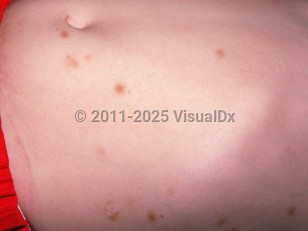Toxocariasis in Adult
Alerts and Notices
Important News & Links
Synopsis

Toxocariasis is a common zoonosis caused by 2 species of Toxocara roundworms: Toxocara canis from dogs and, less commonly, Toxocara cati from cats. It may be found wherever these animals and their respective roundworms can flourish. It is more common in developing countries but is also seen in temperate regions (eg, seropositivity in the United States ranges from 2.5% to 54%). Human infection may occur via accidental ingestion of the eggs from the environment, such as soil contaminated with dog or cat feces, or from ingestion of uncooked animal meat infested with Toxocara larvae.
Toxocariasis occurs most commonly in children due to their poor hygiene and play habits. Two general clinical subcategories exist: ocular and visceral. Visceral infection is mainly seen in children younger than 6 years of age. Ocular manifestations are mainly seen in children 6 years and older.
The range of clinical manifestations is wide. Most patients are asymptomatic. Others may present with generalized pruritus and/or urticaria but without localizing signs or symptoms. Still others may present with wheezing, fever, abdominal pain, and hepatomegaly.
In ocular toxocariasis, patients will present with unilateral visual impairment and/or strabismus. Blindness may occur. Rarely, T. canis larvae can cause eosinophilic meningitis.
Risk factors include exposure to dogs / cats (particularly puppies or kittens), pica (ingestion of non-nutritive substances), lower socioeconomic status, and intellectual disability (institutionalized).
Toxocariasis occurs most commonly in children due to their poor hygiene and play habits. Two general clinical subcategories exist: ocular and visceral. Visceral infection is mainly seen in children younger than 6 years of age. Ocular manifestations are mainly seen in children 6 years and older.
The range of clinical manifestations is wide. Most patients are asymptomatic. Others may present with generalized pruritus and/or urticaria but without localizing signs or symptoms. Still others may present with wheezing, fever, abdominal pain, and hepatomegaly.
In ocular toxocariasis, patients will present with unilateral visual impairment and/or strabismus. Blindness may occur. Rarely, T. canis larvae can cause eosinophilic meningitis.
Risk factors include exposure to dogs / cats (particularly puppies or kittens), pica (ingestion of non-nutritive substances), lower socioeconomic status, and intellectual disability (institutionalized).
Codes
ICD10CM:
B83.0 – Visceral larva migrans
SNOMEDCT:
87121004 – Visceral larva migrans syndrome
B83.0 – Visceral larva migrans
SNOMEDCT:
87121004 – Visceral larva migrans syndrome
Look For
Subscription Required
Diagnostic Pearls
Subscription Required
Differential Diagnosis & Pitfalls

To perform a comparison, select diagnoses from the classic differential
Subscription Required
Best Tests
Subscription Required
Management Pearls
Subscription Required
Therapy
Subscription Required
References
Subscription Required
Last Updated:10/01/2018
Toxocariasis in Adult

